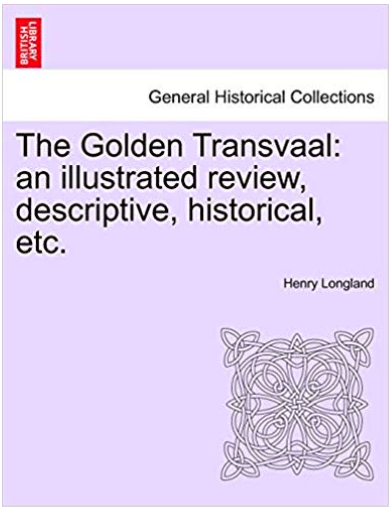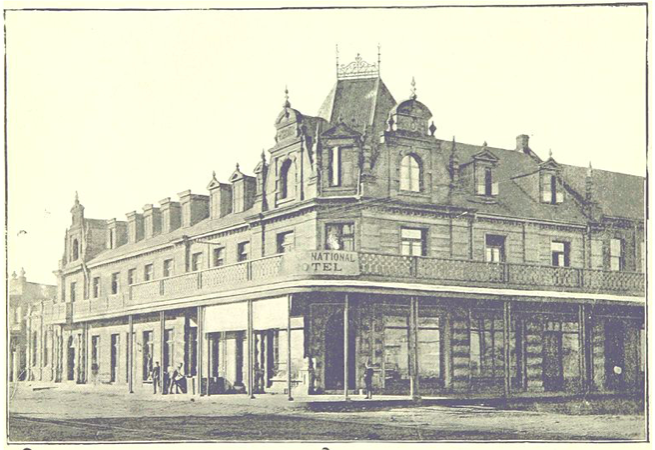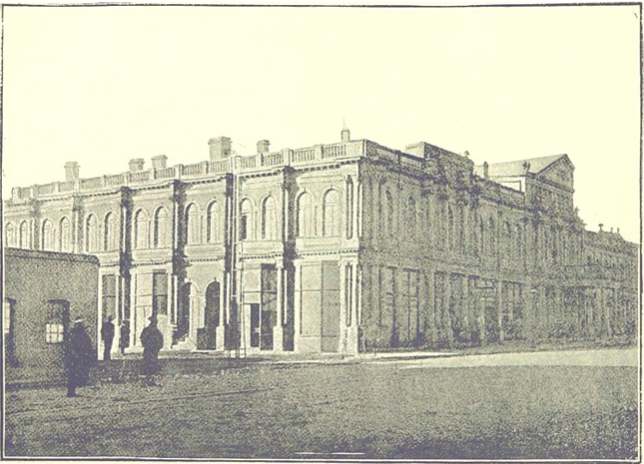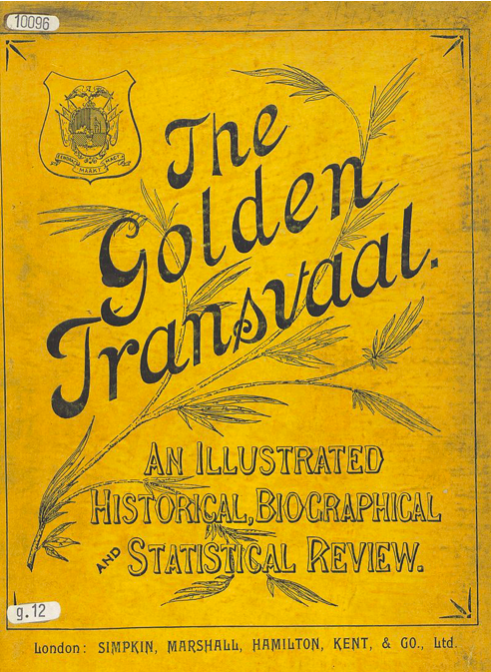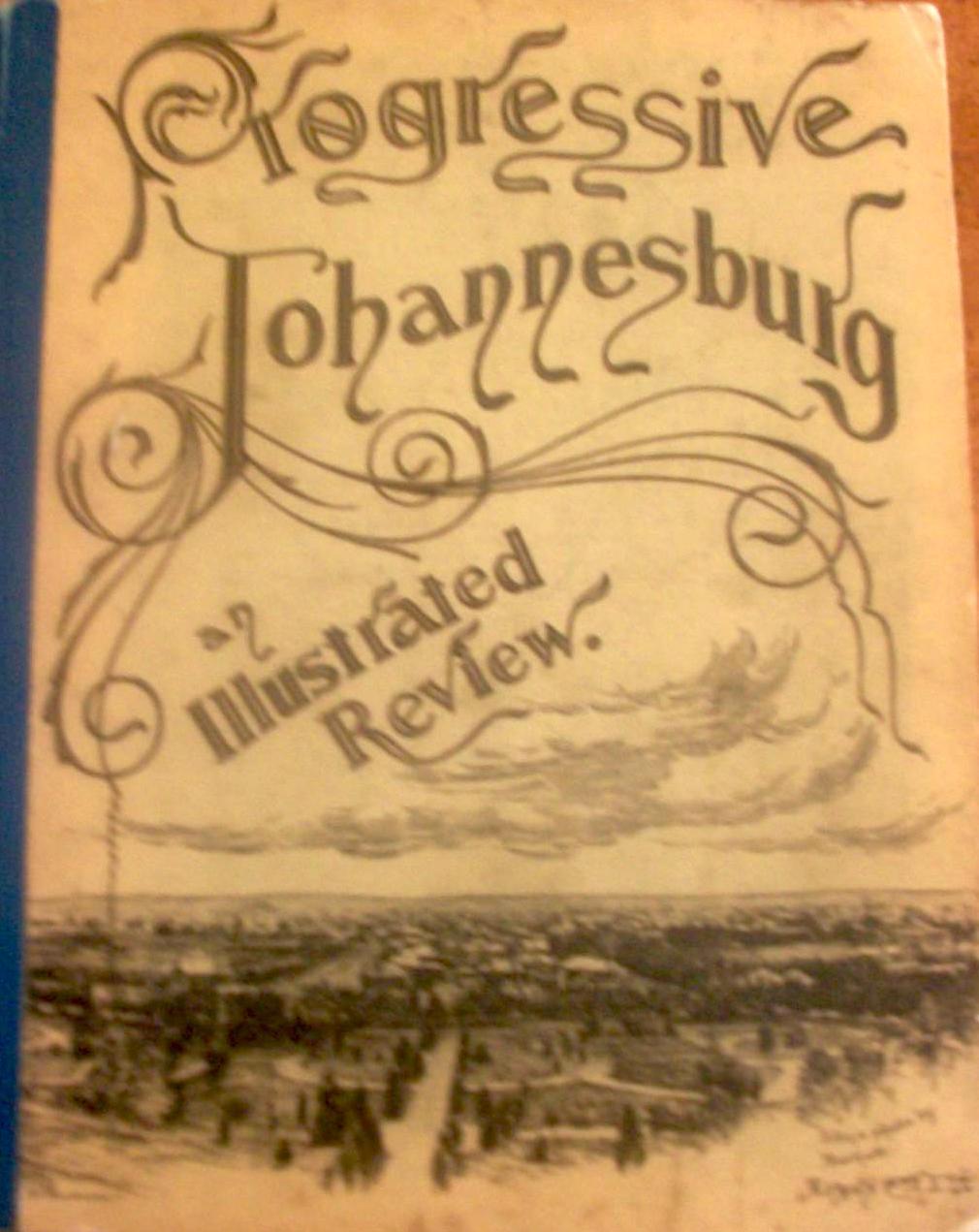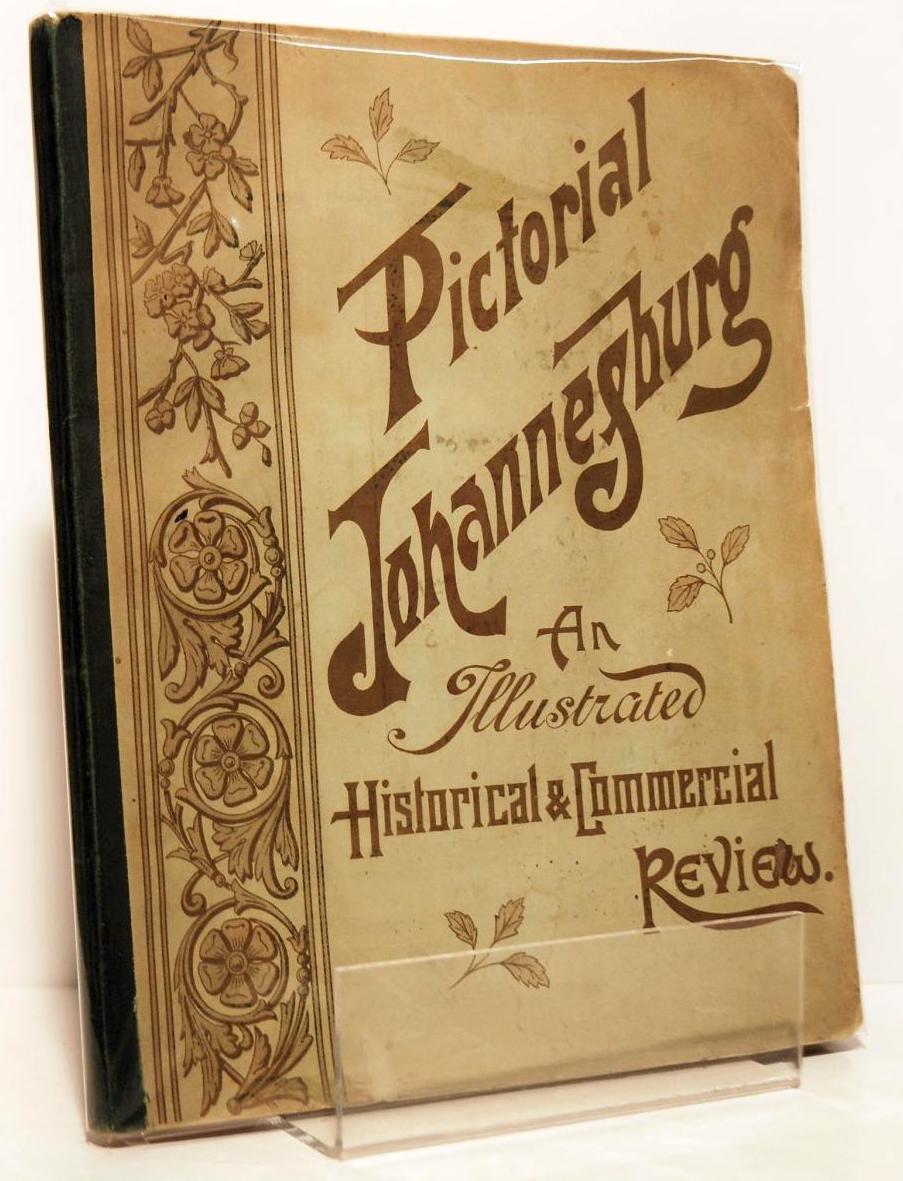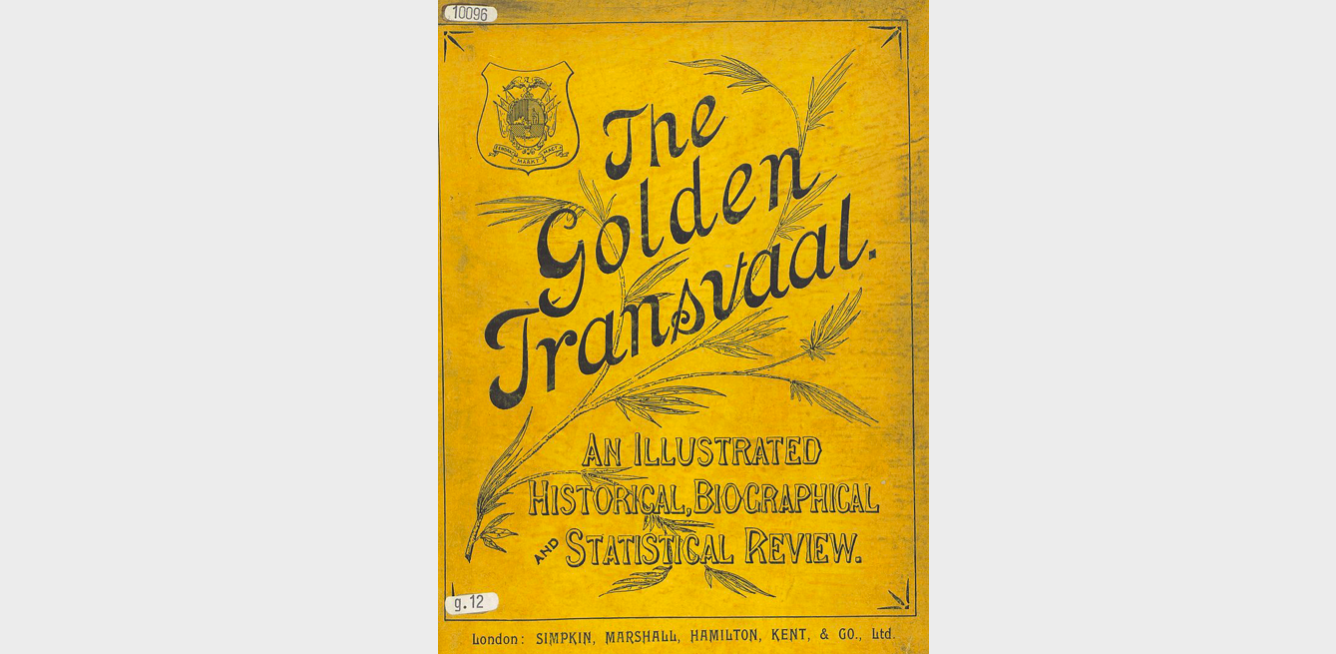
This is a very early survey of Johannesburg circa 1893 by Henry Longland whose 1890s directories are an excellent source of early information about Johannesburg Streets. This slender book, just 60 pages, has been reproduced from the British Museum rare document collection and is available online from Amazon and Abe books.
The latest book cover
The book is all about what Johannesburg was like in 1893, just eight years after its foundation. Interesting though that his title is the Golden Transvaal and it opens with a photograph of President Paul Kruger of the ZAR, as at that date Johannesburg had not yet overwhelmed Pretoria nor had it become the economic powerhouse of the sub-continent. But signs of the future were there and Johannesburg was on its way to permanence and had already leapt beyond the bounds of a rough dusty mining camp.
Johannesburg is described by Longland as a “mushroom city of the Transvaal and it is gold that has brought the metamorphosis.“ The population is given as 50 000 though the 1890 census gives the population as 26 303 and with 261 bars and hotels, alcohol consumption must have been one of the earliest jolly activities. Longland marvels at the speed with which the town grew in eight years: “...there crowd and bustle ceaselessly busy and as unceasingly noisy tens of thousands of people upon the one lonely wilderness.”
Longland’s Johannesburg has at its heart the gold mines of the Witwatersrand with their headgear, crushing mills, batteries, sorting tables and underground rock breaking. By 1893 there are two and three storey buildings, and even the three storey Palace Building with its 5 storey corner spire. There are hotels, a shopping arcade, a stock exchange (already the second building), mining houses, office blocks and a hospital. There is a market square with government buildings imposing order and administration; auction sales happen at the market. Entertainment is organized in the Standard and the Globe Theatres and the Wanderers Club had a club house and athletics track.
Palace Buildings (Davies Brothers)
The Grand National Hotel (J Davis)
The Second Johannesburg Stock Exchange (Gannon and Hawksey)
There are some excellent early black and white photographs of the Market Square, gold mines, Commissioner Street, the Johannesburg Hospital, the first Corner House, the Barnato Buildings, the Stock Exchange, Government Buildings, the Wanderers Club, Palace Buildings and more. Interspersed are the photographs of mines, miners and mining activities as in 1893 the only game in town was gold mining. At that date the problem of pyritic ores had been overcome with the application of the McArthur Forrest process (click here for more details).
It is interesting to see who the photographers of early Johannesburg were - mainly J Davis, but also Duffus Bros. and Gannon & Hawksey. The pamphlet also includes a long speech on the mining industry by Lionel Phillips in his capacity as Chairman of the Chamber of Mines and this gives a very good coverage of the issues of the day in mining grades of ore, output, gold law, labour, gold thefts, liquor consumption and law and order. Phillips considered the “native“ labourers on the mines to have been overpaid.
1893 was an interesting year in that the railway has just arrived and coaches became obsolete. The first train from Cape Town arrived at Park Station on the 15th September 1892. There is a photo of the Hey’s Coach office and the “last coach” and another of the “first train”.
Longland has also included some biographical sketches - his take on the prominent men of 1893, covered Carl Hanau, W H Rogers, Gustave Imroth, B M Woollan, Abe Bailey, E H Dunning, Adolf Goerz with a frontis picture of ‘the late Herman Eckstein'. There is no explanation as to how he chose his Rand pioneers , though I wondered if this was some form of advertorial. Incidentally of that group of 8 pioneers six have entries in the Dictionary of South African Biography but two (Wollan and Rogers) did not catch eternal fame with entries in the DSAB. The book is also interesting because it carries some select adverts – a page devoted to the Chamber of Mines, an advert for the Cape Government Railways (England to Johannesburg and Pretoria in 21 days), the Castle Line Royal Mail Service (weekly sailings from London for the Gold Fields of South Africa), the Union Line and advert for the Sandycroft 10 – Stamp High Bank Battery. Today these adverts become sources of information.
It is a book with a souvenir feel and republication has opened up rediscovery. Unfortunately the quality of the printed text is poor. It looks better on the outside than the inside but it’s the essential early information that is so valuable.
The combination of the mining activity and a town in the making make this book an essential addition to my library. I had previously known about the booklet and had managed to source a photocopy, but little did I expect this title to now carry an ISBN number.
Technology, the concept of the public domain and the British Library in London connect in the publication (or rather should I say republication) of this rare volume. Last month, when in the USA, I ordered the British Library’s reprint.
The British Library has made available its original 1893 publication to be reproduced in order to widen accessibility and address the issues of book preservation. This is part of the Bibliolife Network project to which libraries, archives, online communities and subject experts belong. Their credo is that “every book published should be available as a high-quality reproduction, printed on demand anywhere in the world”. There is a secondary objective in that books in the public domain are able to generate a new revenue stream for libraries and organizations working to preserve these important materials. The British Library and its partners are committed to protecting, preserving and promoting, through authentic reproductions the world’s literature.
The original appearance of the pamphlet / book
There is a further aspect to this endeavour as the 55 or so illustrations are now also accessible on line via Wikimedia Commons and can be accessed quite easily (click here to view).
Who was Henry Longland? At this point I know very little about him. We know of Longland because he published street directories of Johannesburg and Pretoria in the 1890s and there were further publications about Cape Town too. He published two other promotional books on Johannesburg - Progressive Johannesburg and Pictorial Johannesburg.
Longland's other books on Johannesburg
I have found reference to Pictorial Johannesburg online but have not been able to consult a copy. It is described as follows: “An extremely rare document of major importance to South African history, Pictorial Johannesburg (ca. 1893) is a historical and commercial review of the settlement not yet a decade after its naming and foundation in 1886, and predating the outbreak of the Second Boer War by just a few years." The purpose of the publication was to promote Johannesburg as a commercial and mercantile centre, to show pictorially that the city was thriving, no doubt to attract business and further settlement. The book contains numerous advertisements in addition to the photographic and descriptive entries of the city’s main businesses. Among these is an advertisement for Henry Longland, the author himself, as an "Advertising Agent, publisher of the Johannesburg and Pretoria directories for 1892".
It is a profusely illustrated item of ephemera, described as “mainly with black-and-white photographs of Johannesburg". The catalogue described it as follows: “The first half of the volume contains 2 essays: 'Johannesburg: Its Rise and Progress' and 'The Streets of the Golden City, and its Public and Other Notable Buildings', while the second half is a Commercial Review of the city's mercantile establishments, with almost every entry photographed and described.”
This publication is unaffordable but clearly collectable. I am unable to establish anything further about Longland as he seems to disappear from the scene in the 20th century.
Kathy Munro is an Honorary Associate Professor in the School of Architecture and Planning at the University of the Witwatersrand and chair of the Johannesburg Heritage Foundation. She enjoyed a long career as an academic and in management at Wits University. She trained as an economic historian. She is an enthusiastic book person and has built her own somewhat eclectic book collection over 40 years. Her interests cover Africana, Johannesburg history, history, art history, travel, business and banking histories. She researches and writes on historical architecture and heritage matters. She is a member of the Board of the Johannesburg Heritage Foundation and is a docent at the Wits Arts Museum. She is currently working on a couple of projects on Johannesburg architects and is researching South African architects, war cemeteries and memorials. Kathy is a member of the online book community the Library thing and recommends this cataloging website and worldwide network as a book lover's haven.

